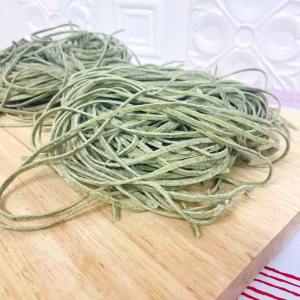HOW TO STORE FRESH PASTA Freezing and other grandmas' tricks

Discover all our clever tricks for having your own fresh pasta supply always ready at home. We have collected everything we have learnt from sfogline (the pasta makers) over the years, remembering the advice handed down from our grandmothers. From the fridge to the freezer, we tested the various best storage methods for fresh pasta. Read on to learn how to never run out of fresh pasta again!

Storing fresh pasta in the fridge
This is its natural environment. Fresh pasta, even that which you have made at home, being moist must be kept in the fridge, preferably in an airtight container for a few days at most. If you have bought it, store the unopened package directly in the fridge. If the fresh pasta has been vacuum-packed then you can eat it by the date indicated on the label. On the other hand, once the packet has been opened, or if you have made it yourself, you should cook the pasta within a few days: a maximum of two or three days for plain fresh pasta up to four days for fresh egg pasta.
Only in the case that you made the fresh filled pasta yourself and did not buy it, then our advice is not to store it in the fridge if you have not blanched it first (see the section on blanching below): in fact, the filling being wet wets the outer sheet, making it too loose and at risk of breaking. Again, this only applies to homemade fresh pasta, not to vacuum-packed pasta. By freezing, however, you take all your worries away and we will explain how later.
Blanching
It is a very common technique in the kitchen and not only limited to pasta, e.g. for vegetables. For fresh pasta, blanching serves to extend the shelf life for a few days. It can also be used for filled pasta. A pot of water is brought to the boil and the pasta is cooked for half the time, then drained and left to dry: either well spaced out on a rack or by adding a little oil to prevent sticking. In this way you can store the pasta for another two or three days in the fridge in an airtight container.
Drying fresh pasta
Fresh pasta differs from dry pasta because in the former case the pasta has not been dehydrated. Fresh pasta cooks in less time while dry pasta has the advantage that it can be stored at room temperature and for a long time. All dry pasta has been fresh pasta but not all fresh pasta can become dry pasta; in fact, filled pasta can only be stored fresh (or frozen).
Drying is a method used either professionally by pasta makers or if you want to make pasta at home. Drying bought fresh pasta is less convenient than freezing it. To dry pasta, it must be exposed to the air, well spaced out: this is why, for example, for long pasta, tools similar to drying racks are used to dry the dough well. In artisanal pasta factories, this phase can last up to two days: everything depends on the ambient temperature and humidity. If you don't dry the dough well, the risk is that it will become mouldy, which is why we recommend other home preservation methods, such as freezing.
Freezing fresh pasta

For stocking up on fresh pasta, the freezer is your best ally. On the one hand you have the convenience of saving money on the purchase of large quantities (find all our fresh pasta offers here) and on the other hand you no longer have the thought of having to use the pasta within a few days. Frozen fresh pasta can be stored in the freezer for at least two months (check your appliance instruction booklet for more information). Once the pasta is frozen, it can then be cooked in the same way as fresh pasta.
Even though it is very easy to freeze fresh pasta, some precautions must always be taken. It is absolutely not advisable to put the packet of pasta, as it is, unopened inside the freezer: this is because fresh pasta being moist will stick and stick if not dried first. So here's what you need to do when you want to freeze fresh pasta of any kind.
1) take a tray and sprinkle some semolina flour on top
2) distribute the dough well, spacing it out on top of the tray
3) sprinkle with more semolina flour and cover with film
4) place in the freezer and after 1 hour take out and portion the dough into bags or other containers, as you prefer

How to make fresh pasta nests (tagliatelle, taglierini, etc.)
To store long fresh pasta, such as tagliatelle or taglierini, you need to arrange it in such a way that it can be easily portioned, which is why we recommend making pasta nests. These pasta nests should ideally already correspond to your usual portion size, so that you no longer need to weigh the pasta.
To make these nests, first unravel the pasta and take it as if it were a streamer. Grab the pasta from the tips all together, so that they are as even as possible. Fold the tips over your index finger and let them meet the centre, halfway. Without twisting the strands of pasta on themselves, bring the pasta up and loop it over your hand like a ball of yarn, which is nice and open to create a hole. Make the turns, above and below the hand, until you have your ball of dough. Again with your fingers open, then place the dough on a surface. Take care that no knots are formed.
How to use frozen pasta
By now you will have your bags of fresh pasta in the freezer neatly arranged, preferably labelled with the date of when you froze them. All ready to be used whenever you like. In fact, the great thing about frozen fresh pasta is that it doesn't need to be defrosted, it just drops into boiling water as soon as you take it out of the freezer. This applies to both normal fresh pasta and fresh filled pasta.
Since the pasta is frozen, remember that the cooking time will change slightly, increasing by only a few minutes. When you throw the long pasta into the boiling water, do not stir it immediately but wait until it is soft enough to turn it without breaking it.
Do you have further questions on how to store fresh pasta or on our products?
We are an e-commerce but also a trattoria, so it is normal for us to answer questions from those who sit at our table. So if you have any other questions about food preservation or would like to know more about our products, such as fresh pasta and sauces, feel free to write to us on our WhatsApp number (click here) or email info@molomodo21.it
If you would like to know more, we leave you the links to our other articles:
- Fresh Ligurian pasta: portions, how long it takes to cook and how to season it
- Pesto Genovese: when it expires, how to store it and how to freeze it















